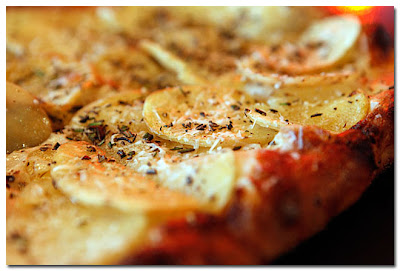
One part of taking a vacation is checking out the local eats. And when you’re in a city like Seattle, it’s easy to go crazy trying to sample as diverse a menu as humanly and gastronomically possible in four days.
Unfortunately, we failed in that endeavor.
We thought about taking a culinary tour through Pike Place Market. It was about $40 per person and took a couple of hours walking around the market area sampling some of the local flavors: seafood, chocolate, chowder, wine and beer.
Instead, we decided to head out on our own.
From the get-go, our method for culinary satisfaction was flawed. We found the restaurants that we wanted to eat at and bellied up for a good lunch or dinner. Don’t get me wrong, the food was great. It’s just that at most, we were hitting three restaurants a day. That’s 12 restaurants over four days. Not good numbers considering Seattle has about 1000 dining establishments. The numbers were against us from the beginning.
We did eat good though. The location of our hotel guaranteed that.
Staying at the Warwick Hotel at the corner of 4th and Lenora, we were within stumbling distance of some of Seattle’s best restaurants. In the hotel was Brasserie Margaux. Nearby, literally next door and catty-corner to the hotel, were four of Tom Douglas’ restaurants: Serious Pie, Lola’s, Dahlia Lounge and the Dahlia Bakery. Next to Lola’s was the Italian restaurant Assaggio Ristorante. We couldn’t have found a better location for our hotel.

The mornings started pretty much the same. We’d hit the Dahlia Bakery for our morning pastry and find the nearest Starbucks for our morning jolt of caffeine.
Those two became regular stops throughout the day. In the morning it was a croissant or a fig bar as big as the palm of your hand from the bakery and cup of coffee from Starbucks. And in the afternoon it was usually something sweet: a peanut butter cookie that is actually two cookies glued together with rich peanut butter or a Coco Pie Bite, a tempting sample of triple coconut cream pie that leaves you craving the whole pie.
And this wasn’t the only Tom Douglas restaurant that we favored.

We made a couple of stops at Serious Pie, which is some of the best pizza I’ve ever eaten. And the pizza may not have been the best item on the menu.
Each time we ate at Serious Pie there was a wait. Not excruciatingly long, but long even for the smells from the kitchen to overcome you. It may as well have been Pavlov’s bell, because the moment the aromas hit your nasal passages, your mouth started to water.
On our first visit, we started with the Roasted Pumpkin, Arugula Pesto and Hazelnuts Salad. And our pizza of choice was the Cherry Bomb Peppers and Sweet Fennel. I could have just eaten the salad and been happy.
The next visit was the Beets, Anchovy, Pistachios and Mint Salad with a Yukon Gold Potato, Rosemary and Pecorino Pizza. Another great meal.

We soon realized was our problem. We were spending precious time and stomach space to eating meals at these restaurants. It took us a few days to realize the error of our ways. We needed to eat like we were on the culinary tour; eat samples instead of full meals. How could we have not realized this sooner?
It’s all about small bites. Most of the restaurants served appetizer-sized items of their best entrees. Cutters Bayhouse had most of theirs on a happy hour menu. Nothing like getting more bang for your buck. We managed to sample their Tempura Battered Beecher’s Cheese with Pepper Jelly, Calamari with Lemon Garlic Aioli and Seared Washington Dungeness Crab Cakes.

Meandering through Pike Place Market, samples were plentiful: from fresh Honeycrisp Apples, to chocolate linguine, to raw hazelnuts. You could eat three meals without ever setting foot in a restaurant, but truth be told, we did pay for at least one meal in the market.
Some people eat at the Market Grill for the fish sandwiches, I was here for the clam chowder. After all, it was ranked as one of the top places to eat as reviewed in one of my mom’s travel books. And how can you disagree with an unbiased publication like a travel book?

As our days of wandering the market and Seattle came to a close each night, we retreated to the warm, cozy confines of the Warwick to rest our weary feet and recover for the next day. And as a reward for walking away all the calories we consumed throughout the day, we made time to visit Brasserie Margaux for a little nightcap. Of course our nightcaps included sampling the dessert tray. With offerings like Chocolate Lava Cake, Tiramisu a la Margaux, and Creme Brulee, how better to end the day?
Naturally, my heart, and stomach, fell a little when we had to leave Seattle. But we were able to prolong our culinary food tour for at least one leg of our return flight home. Tucked away in my mom’s carry-on were a few Honeycrisp Apples and some hazelnuts from the market.
















